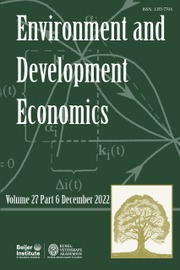Crossref Citations
This article has been cited by the following publications. This list is generated based on data provided by
Crossref.
Davis, Peter
and
Ali, Snigdha
2014.
Exploring Local Perceptions of Climate Change Impact and Adaptation in Rural Bangladesh.
SSRN Electronic Journal,
Ahmed, Shakil
Rahman, Md. Mafizur
Shams, Shahriar
and
Pasha, Md. Mosabbir
2014.
Assessment of Temporal and Spatial Variation of Pan Evaporation with Related Climatological Factors in Bangladesh.
APCBEE Procedia,
Vol. 10,
Issue. ,
p.
257.
Drees, Lukas
and
Liehr, Stefan
2015.
Using Bayesian belief networks to analyse social-ecological conditions for migration in the Sahel.
Global Environmental Change,
Vol. 35,
Issue. ,
p.
323.
Hauer, Mathew E.
Evans, Jason M.
and
Alexander, Clark R.
2015.
Sea-level rise and sub-county population projections in coastal Georgia.
Population and Environment,
Vol. 37,
Issue. 1,
p.
44.
Millock, Katrin
2015.
Migration and Environment.
Annual Review of Resource Economics,
Vol. 7,
Issue. 1,
p.
35.
Viswanathan, Brinda
and
Kavi Kumar, K.S.
2015.
Weather, agriculture and rural migration: evidence from state and district level migration in India.
Environment and Development Economics,
Vol. 20,
Issue. 4,
p.
469.
Tucker, Josephine
Daoud, Mona
Oates, Naomi
Few, Roger
Conway, Declan
Mtisi, Sobona
and
Matheson, Shirley
2015.
Social vulnerability in three high-poverty climate change hot spots: What does the climate change literature tell us?.
Regional Environmental Change,
Vol. 15,
Issue. 5,
p.
783.
Neumann, Kathleen
and
Hilderink, Henk
2015.
Opportunities and Challenges for Investigating the Environment-Migration Nexus.
Human Ecology,
Vol. 43,
Issue. 2,
p.
309.
Lu, Linjun
Lu, Qing-Chang
and
Rahman, ABM
2015.
Residence and Job Location Change Choice Behavior under Flooding and Cyclone Impacts in Bangladesh.
Sustainability,
Vol. 7,
Issue. 9,
p.
11612.
IQBAL, KAZI
and
ROY, PARITOSH K.
2015.
CLIMATE CHANGE, AGRICULTURE AND MIGRATION: EVIDENCE FROM BANGLADESH.
Climate Change Economics,
Vol. 06,
Issue. 02,
p.
1550006.
Ramos, Maria da Conceição Pereira
Ramos, Natalia
and
Moreira, Ana Isabel da Rocha
2016.
Climate Change and Health.
p.
403.
Klabunde, Anna
and
Willekens, Frans
2016.
Decision-Making in Agent-Based Models of Migration: State of the Art and Challenges.
European Journal of Population,
Vol. 32,
Issue. 1,
p.
73.
Dallmann, Ingrid
and
Millock, Katrin
2017.
Climate Variability and Inter-State Migration in India.
CESifo Economic Studies,
Vol. 63,
Issue. 4,
p.
560.
Groeneveld, Jürgen
Klabunde, Anna
O’Brien, Michelle L.
and
Grow, André
2017.
Agent-Based Modelling in Population Studies.
Vol. 41,
Issue. ,
p.
237.
Suleimenova, Diana
Bell, David
and
Groen, Derek
2017.
A generalized simulation development approach for predicting refugee destinations.
Scientific Reports,
Vol. 7,
Issue. 1,
Bohra-Mishra, Pratikshya
Oppenheimer, Michael
Cai, Ruohong
Feng, Shuaizhang
and
Licker, Rachel
2017.
Climate variability and migration in the Philippines.
Population and Environment,
Vol. 38,
Issue. 3,
p.
286.
Falco, Chiara
Donzelli, Franco
and
Olper, Alessandro
2018.
Climate Change, Agriculture and Migration: A Survey.
Sustainability,
Vol. 10,
Issue. 5,
p.
1405.
Nguyen, Hung Khanh
Chiong, Raymond
Chica, Manuel
and
Middleton, Richard H.
2018.
Agent-based Modeling of Inter-provincial Migration in the Mekong Delta, Vietnam: A Data Analytics Approach.
p.
27.
Davis, Kyle Frankel
Bhattachan, Abinash
D’Odorico, Paolo
and
Suweis, Samir
2018.
A universal model for predicting human migration under climate change: examining future sea level rise in Bangladesh.
Environmental Research Letters,
Vol. 13,
Issue. 6,
p.
064030.
Boulahbel-Bachari, Samira
El Saadi, Nadjia
and
Bah, Alassane
2018.
Applied Computational Intelligence and Mathematical Methods.
Vol. 662,
Issue. ,
p.
338.

